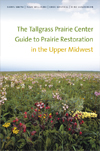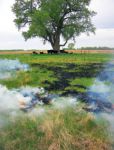The Ecology and Management of Prairies in the Central United States
“Chris Helzer’s book is the first I’ve seen that plainly defines the contents of prairies and then tells you how to care for them. Smart, well researched, practical, and to the point, this book is one-stop shopping for anyone who cares about grasslands, now or in the future.”—Joel Sartore, contributing photographer, National Geographic Magazine, and author, Rare: America’s Endangered Species
“Chris Helzer’s Ecology and Management of Prairies in the Central United States is an excellent guide for prairie managers, restorationists, and prairie enthusiasts. Helzer covers many more aspects of prairie biology and function than previous authors, including macro and micro organisms, plant communities, fire and herbivory, and the effects of fragmentation on genetic flow and prairie wildlife. He also covers seed selection, determining fill, planting methods, and weed control and has a section on methods for invasive control rarely mentioned in prairie restoration books. This book is a welcome aid to any serious prairie enthusiast.”—Stephen Clubine, grassland biologist, Missouri Department of Conservation
Most prairies exist today as fragmented landscapes, making thoughtful and vigilant management ever more important. Intended for landowners and managers dedicated to understanding and nurturing their prairies as well as farmers, ranchers, conservationists, and all those with a strong interest in grasslands, ecologist Chris Helzer’s readable and practical manual educates prairie owners and managers about grassland ecology and gives them guidelines for keeping prairies diverse, vigorous, and viable.
Chapters in the first section, "Prairie Ecology", describe prairie plants and the communities they live in, the ways in which disturbance modifies plant communities, the animal and plant inhabitants that are key to prairie survival, and the importance of diversity within plant and animal communities. Chapters in the second section, "Prairie Management", explore the adaptive management process as well as guiding principles for designing management strategies, examples of successful management systems such as fire and grazing, guidance for dealing with birds and other species that have particular habitat requirements and with the invasive species that have become the most serious threat that prairie managers have to deal with, and general techniques for prairie restoration. Following the conclusion and a forward-thinking note on climate change, eight appendixes provide more information on grazing, prescribed fire, and invasive species as well as bibliographic notes, references, and national and state organizations with expertise in prairie management.
Grasslands can be found throughout much of North America, and the ideas and strategies in this book apply to most of them, particularly tallgrass and mixed grass prairies in eastern North Dakota, eastern South Dakota, eastern Nebraska, eastern Kansas, eastern Oklahoma, northwestern Missouri, northern Illinois, northwestern Indiana, Iowa, southwestern Wisconsin, and southwestern Minnesota. By presenting all the factors that promote biological diversity and thus enhance prairie communities, then incorporating these factors into a set of clear-sighted management practices, The Ecology and Management of Prairies in the Central United States presents the tools necessary to ensure that grasslands are managed in the purposeful ways essential to the continued health and survival of prairie communities.
Preface vii
Acknowledgments ix
Introduction xi
prairie ecology
1 Plant Communities 3
2 The Role of Disturbance 13
3 Animal Communities 25
4 The Importance of Diversity and Heterogeneity 49
5 Landscape Context 59
prairie management
6 The Adaptive Management Process 69
7 Guiding Principles for Designing Management Strategies 79
8 Examples of Management Systems 91
9 Managing for Wildlife with Particular Requirements 135
10 Invasive Species 143
11 Restoration 161
Conclusion 169
A Note on Climate Change 173








